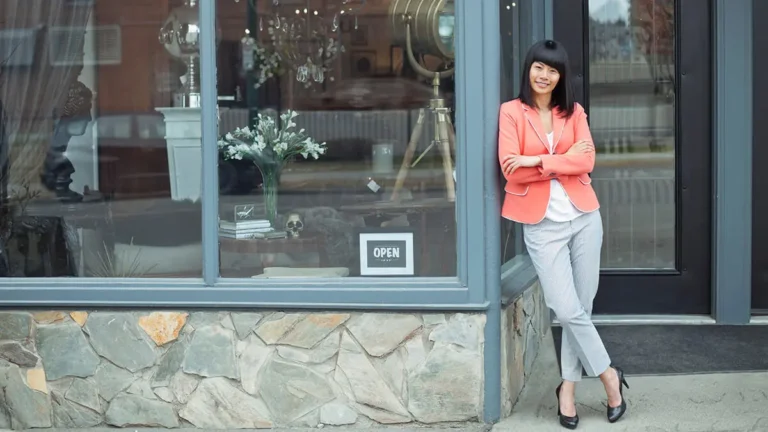Business cards have been used by professionals for decades. As a business owner, having these cards handy might make the difference between being remembered and forgotten. But in the digital age, are business cards still relevant?
Read on to learn more about business cards, whether you should use them for your business, and how to create them.
What is a business card?
A business card, typically smaller than the size of an index card, is a networking tool that contains information about an individual or company.
What you include on your business card varies. Generally, business card information includes an individual’s name and position, company name and website, and contact information such as phone number, fax number, email address, business address, and social media sites. Business cards should also have your business’s logo to improve brand recognition and consistency. And, you could add additional information, like hours of operation.
You can give business cards to potential customers or clients, investors or lenders, other business owners, and even vendors. Use business cards when customers come into your business, pass them out at networking events, and have them handy when meeting with small business advisers.
For the most part, business cards are easy to make or inexpensive to have someone else design them. You can print cards yourself if you have cardstock and a simple design program. Or, you can outsource the entire process. Depending on how you create them, business cards can cost between $10 to $500.
Should you use business cards?
Using entrepreneur business cards to promote your small company is up to you. Take a look at some of the pros and cons of using business cards below.
Business card pros
There are many reasons why you need a business card. In addition to being a relatively inexpensive asset, here are some pros to using business cards.
Using business cards to network is popular. According to one source, 27 million business cards are printed daily. Because business cards are so popular, it’s likely you’ll receive them at some point. Receiving business cards from other businesses and providing nothing in return is fruitless for some companies. And in some cases, it can be seen as rude.
Although we live in the digital age, giving business cards can help you connect with an old-school audience. Some people don’t like using the internet to find your business, and failing to connect with them might cause you to isolate this group. Plus, people don’t always have access to the internet, and referencing business cards might be more convenient.
Business cards also add a professional touch to your company. Many individuals expect you to have cards handy. If you use business cards, you can be prepared the next time someone says, “Do you have a business card?”
Business cards can even increase sales. For every 2,000 cards you pass out, you could see an increase in sales of 2.5%. The more sales you make, the bigger the boost your company’s bottom line will receive.
Branding is an imperative part of operating a memorable, successful business. Creating business cards gives you an opportunity to advertise your business and increase brand recognition.
Business card cons
Take a look at some reasons you might opt out of using business cards.
Business cards might be susceptible to wear and tear. Laminating cards might help, but they are still subject to the elements. And, recipients could easily lose cards.
Many people don’t want to receive business cards. Business cards can clutter purses, pockets, and office desks, which results in the majority of recipients throwing cards away. Eighty-eight percent of distributed business cards are thrown away in less than a week.
Instead of using business cards, many professionals connect via the social media platform for networking, LinkedIn. Adding contacts via LinkedIn is easy to do, and both parties have access to more information than what is displayed on a business card.
If you view a business card as a formality that you could do without, you might decide not to use them. Designing business cards takes time and innovation, which might be a waste of time if you’re handing them out just to go through the motions.
Business cards: yes or no?
Instead of picking a side in the business card debate, you might land in the middle.
You can supplement business cards with an online presence. Make sure you have a small business website and social media accounts to stay connected to the four billion people who use the internet.
Use business cards to introduce your company to others, and get them to interact with your business by following up with them. Connect with recipients on LinkedIn and other social media platforms. Collect email addresses and use email campaigns to reach out.
If you provide business cards when appropriate and connect with customers and others online, you can appease all audiences, get double the promoting power for your business, and remain professional.
How to create a good business card
Designing your business card can be a fun responsibility. Even if you outsource it, you might have an idea of what you want to include. A good business card design could lead to more customers, networking opportunities, and connections.
So, what makes a good business card? Take a look at these business card tips to get started.
1. Include your logo
Your business logo is a symbol that identifies your business. When you think of your favorite brands, each company’s iconic logo probably comes to mind. What is your business’s logo?
If you don’t have a logo, you might consider focusing on making one first. Once you have your business’s logo, include it on all your marketing and promotional materials, including your business card.
Adding your logo to your business card increases your brand’s visibility. By including your logo on all your marketing materials, your brand is tied together. Consistency is key to successful branding, and adding your logo to your business card is a great way for people to get to know your business.
2. Incorporate your business’s colors
Standard black and white business cards will work, but adding extra color makes them more eye-popping. According to one source, a business card with color stays with a recipient approximately 10 times longer than a standard black and white card.
You shouldn’t pick just any colors for your business card. Your business should have one or a few colors representing it. For example, we use shades of blue at Patriot Software. Your colors should be consistent on your website, logo, business cards, and other company-related materials.
3. Use strong material
Don’t use thin, copy paper. If you use copy paper to make your business cards, they will damage easily. And, people might not take your business as seriously if you use thin business cards.
Instead, use a strong material that can last longer. Regular or premium card stocks are standard business card options. Both are sturdy, with premium being a little thicker than regular card stock. You might also coat cardstock so it has a glossy, cleaner finish. Or, you can use plastic business cards. You may decide to get creative and use other materials that fit your business.
Whatever you decide to use, make sure it does not rip easily. And, the material should make the business card look professional.
4. Decide what information to include
Choosing the information to go on the business card is the most important decision you can make when designing your card. You want to include enough information to show off your business, but including too much can make your card cluttered and difficult to read.
As mentioned earlier, here’s some information you might decide to include on your business card:
- Your name
- Your position
- Company name
- Website
- Address
- Phone number
- Fax number
- Email address
- Social media sites
- Business logo
- Mission statement
You might decide to use both sides of the business card. For example, you could devote one side entirely to your company’s logo and include information about your small business on the reverse side. Using both sides can give you more room to include extra information.
You determine your business card template. Information that works for one business might not work for you. For example, if you run an eCommerce business, you don’t need to include your address.
5. Determine the size and shape
Handing out a sheet of paper with information about your business is not ideal. You need to distribute business cards that are small enough that recipients can store in their wallets. The standard business card size is 3.5 X 2 inches, but the size of your card can vary. Be sure not to create cards that are too big or too small.
As far as the shape of your card goes, you can get creative. Your card doesn’t have to be a perfectly cut rectangle. Instead, you can do rounded corners or even opt for distinct shapes.
Business card examples
Here are a few examples of business cards.





